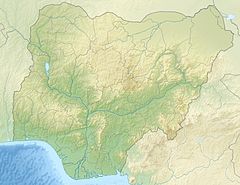| Oṣun River Odò Ọ̀ṣun | |
|---|---|
 A road crossing over the Osun river between Oyo and Osun states. | |
| Location | |
| Country | Nigeria |
| Region | Osun State |
| Physical characteristics | |
| Source | |
| • location | Ekiti Hills, near Igede Ekiti |
| • coordinates | 8°20′N 5°16′E / 8.333°N 5.267°E |
| Mouth | |
• location | Lekki Lagoon |
• coordinates | 6°33′48″N 4°03′43″E / 6.563210°N 4.062032°E |
| Basin features | |
| Tributaries | |
| • left | Erinle River, Oba River |
The Oṣun River (sometimes spelt Oshun), Yoruba: Odò Ọ̀ṣun, is a river of Yorubaland that rises in Ekiti State and flows westwards into Osun State before turning southwestwards at its confluence with the Erinle River near the town of Ede and then heading south at the Asejire reservoir flowing though the rest of the state and Ogun State in Southwestern Nigeria before eventually discharging into the Lekki Lagoon and the Atlantic at the Gulf of Guinea.
The river is named after the Oṣun or Oshun, one of the most popular and venerated Orishas.[1] The annual traditional worship at the Ọṣun Shrine near the Ọṣun River at Osogbo has become a popular pilgrimage and important tourist attraction, drawing people from all over Nigeria and abroad to the annual festival in August.
Osun River is one of the river goddesses in Yorubaland, she is noted for providing for the needs of the people. She was reputedly one of the wives of ̣Ṣango, the Yoruba god of thunder. Osun is a native of Igede-Ekiti, headquarters of Irepodun/Ifelodun local government area, Ekiti state, Nigeria hence her main source is situated at Igede-Ekiti. Osun, third child of the marriage between Ake (a hunter and prince from Ile-Ife) and Erindo (Ake's wife) that would also gave birth to fifteen more children including the popular Rivers Ogbese and Elemi. While Ogbese was the brand legend of the old Afrikola, Elemi river continues to adorn the beauty of our land. Osun, the second wife of Alafin Sango, turned to a river after she lost in the contest of who succeeds their father, Ake. In the Olden days during war times, incantation was the most potent form of weapon. Hence, the smartest and the very vast one carries the day. My town's name, "Igede" was a derivative of "Ogede"- meaning incantation and finally became "Igede" by nominalisation. So, "Ilè Ògèdè or Igede means the land of incantation. Igede-Ekiti is home to more than sixteen rivers, and it hasn't been proven otherwise by anyone or any documents that no river flows into Igede-Ekiti from anywhere. Instead, rivers flow from Igede-Ekiti to other towns and places. It is an Old belief that the river goddess has been able to give babies to the barren women and change the lives of many people.[2] And also there has been many fictional stories about goddess Osun, for example, Shegun Coker and the cursed temple by Kolawole Michael, 2008.[3]
In 2018, the river suddenly began to change color and investigation by Urban Alert (a civic-tech nonprofit organization) has revealed that illegal and unregulated licensed gold mining activities at the headwaters upper course is the root cause.[4] The activities of these miners have contaminated the river with heavy metals, thereby threatening the river and the Osun Osogbo Sacred Grove.
- ^ Murrell, Nathaniel Samuel (2009). Afro-Caribbean Religions: An Introduction to Their Historical, Cultural, and Sacred Traditions. Temple University Press. ISBN 9781439901755.
- ^ Katen Tate (2005). Sacred Places of Goddess: 108 Destinations. CCC Publishing. p. 132. ISBN 9781888729177.
- ^ Joseph M. Murphy, Mei-Mei Sanford (2001). Osun across the Waters: A Yoruba Goddess in Africa and the Americas. Indiana University Press. p. 10. ISBN 9780253108630.
- ^ "INVESTIGATION: How illegal mining fuels poverty, river pollution, sacred grove desecration in Osun". TheCable. 20 June 2022. Retrieved 24 June 2022.
